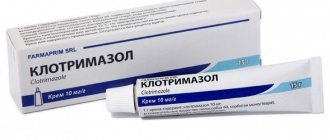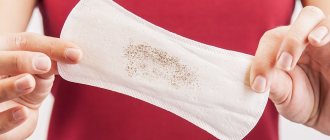Causes of unpleasant symptoms
A healthy woman should have discharge, but it looks like a normal secretion, which is what it is. This is a colorless liquid secreted by our organs in moderate quantities, odorless and does not cause any problems. A healthy secret never stains your laundry. The amount increases before the start of the menstrual cycle, with general malaise of the body or during sexual intercourse, but even then it has a moderately viscous structure of a transparent color.
If a woman begins to be bothered by itching and burning, the natural structure becomes viscous, an unpleasant odor appears or the color becomes white, yellow or grayish - it’s time to rush to the hospital. These symptoms include pain in the pelvic area, discomfort during or before urination, and body temperature may rise. Such discharge is a symptom of the underlying disease, and not an independent phenomenon, so it is necessary to make a diagnosis and find out the causes. They may be:
Candidiasis
- Hormonal disorders of varying degrees. They appear before menstruation, during menopause, during and after pregnancy, and with pathological changes in the body, for example, with diseases of the thyroid gland.
- Allergic reactions due to medications, uncomfortable synthetic underwear, contraceptives, food products, etc.
- Symptoms of inflammatory processes in the pelvic organs.
- Venereal diseases.
Allocations are divided into:
- Cervical, which appear due to hormonal problems, the formation of polyps on the cervix, and infections.
- Uterine signals indicate inflammatory processes in the uterus: fibroids, polyps or cancer.
- Tubal leucorrhoea appears due to inflammatory diseases in the fallopian tubes.
- Vaginal discharge occurs from irritation, damage, or mucous infection.
Inflammation of the genital organs
In the lives of most women, inflammatory diseases of the reproductive system are present. The most common of them are:
- adnexitis;
- salpingo-oophoritis;
- oophoritis;
- colpitis;
- vaginitis and others.
Most often, they are caused by opportunistic flora, and provoking factors include hypothermia, frequent changes of sexual partners, decreased immunity, neglect of personal hygiene rules and other factors. The clinical picture is pain in the lower abdomen, clear discharge, or profuse mucous leucorrhoea. Sometimes the discharge may be yellow and odorless. The diagnosis is made based on examination of a vaginal smear, bacteriological culture, and pelvic ultrasound data.
Candidiasis
One of the most common diagnoses is candidiasis or thrush. The main symptom is a curdled white discharge that smells like sour milk. Candidiasis can spread only to the external organs, then this is vulvitis, to the inside of the vagina - vaginitis, or involve both - vulvovaginitis.
Taking a smear test
During thrush, microcracks appear, causing pain or even bleeding. The itching and burning are unbearable, which disrupts the natural rhythm of life. The causes of candidiasis may coincide with the list indicated in the first chapter, or be a consequence of infection.
It is interesting that a man does not always know about the disease. Thrush in the male body is often asymptomatic, but must be treated together with the woman.
Treatment for candidiasis should be symptomatic - douching, lotions, baths, ointments, suppositories, and the main thing - internal medication to restore balance in the body. Itching, burning and odorless white discharge disappear within a week without leaving a trace. But this infection is classified as a fungal infection and occurs repeatedly over different periods of time.
Treatment
In cases where the cause of dryness is a hormonal imbalance, the specialist prescribes estrogen-based drugs.
In addition, the following treatment methods can be used:
- Vaginal rings. This is a special device that ensures a dose of hormones enters the vaginal tissue for 3 months.
- Vaginal creams. Gels are inserted into the vagina using a special applicator. Thanks to this administration, a uniform effect of the drugs on the vaginal tissue is ensured, as a result of which the symptoms disappear.
- Preparations in the form of suppositories and tablets. Treatment involves the administration of 1 tablet or suppository per day for 14 days, then maintenance therapy is carried out - one tablet 1-2 times a week.
These treatment options are the most commonly used. In some cases, as a rule, when it is necessary to treat older women, systemic drugs are prescribed. Thanks to taking hormone replacement drugs, the effect can be achieved quite quickly - in 1-2 days. Under the influence of active components, the volume of lubricant secretion increases and the elasticity of vaginal tissue increases.
There is also a treatment option that does not involve the use of hormones.
For mild dryness and a slight deviation in estrogen levels from the norm, medicinal herbs can be used. To treat such cases, it is important to use boron uterus, sage, hops, oregano, and red brush. The action of these herbs is aimed at improving blood microcirculation.
Homeopathy remedies can also be used. Drugs in this category include Klimadinon, Cyclodinone.
Bacterial vaginosis
The disease is sexually transmitted and is accompanied by similar symptoms as the previous one, but the itching, burning sensation and white discharge in this case are caused by bacterial infection.
Uterus and vagina
Often, leucorrhoea acquires a grayish or greenish color and a disgusting smell of rotten fish. They become viscous and stringy.
Despite the slight differences, women confuse the two diseases and use the wrong medications to eliminate problems. Bacterial vaginosis is treated with antimicrobial agents, and candidiasis is treated with antifungal agents.
Lack of diagnosis often leads to inflammation of the ovaries and uterus. An important stage of treatment should be taking medications to restore the balance of lactobacilli, otherwise the symptoms will not disappear completely, but will become chronic.
Why does discomfort occur during menstruation?
Statistics say that every woman has felt itching in an intimate place during menstruation at least once in her life. This is due to the fact that during this period various kinds of hormonal disruptions can occur in the body. In addition, itching and dryness of the intimate area can occur against the background of disorders of the thyroid and pancreas. Diabetes mellitus can also provoke discomfort, for the same reason. After the hormonal levels have stabilized, the itching and dryness go away on their own, and no additional treatment is required in this case.
In addition, the cause of unpleasant sensations may be an infection, but if this phenomenon is repeated with enviable regularity, then the cause of this phenomenon is most likely a decrease in the level of the hormone estrogen during certain periods of life. However, to make sure of this, you still need to consult a gynecologist for advice. You may still need to use special vaginal tablets or suppositories that contain hyaluronic and lactic acid.
Cervicitis
Cervicitis
The disease occurs in the lower cervix. The discharge becomes cloudy, contains an admixture of pus, and has a putrid odor. Concomitant diagnoses include erosion or pseudo-erosion of the cervix, inflammation of the vulva.
Treatment is accompanied by taking antibiotics, antifungal medications and antiviral drugs, but the most important thing is to eliminate the cause. For this purpose, special studies are carried out: colposcopy, smears and flora cultures are taken. An extensive blood test will be mandatory.
Changes
4.1. Contact allergy
Quite often there is an allergic reaction from the genital organs to intimate hygiene products or the material from which underwear is made. In this case, the mucous membrane of the vulva and vagina is itchy and itchy, there may be redness and slight swelling.
Another case is intolerance to the powder used in washing. Sometimes women notice the appearance of symptoms when using scented sanitary pads and tampons.
4.2. Irritation after shaving
The main source of itching in this case is growing hard hairs that resemble stubble. As a rule, itching occurs mainly in the pubis, the skin of the labia majora and the inguinal folds in contact with them.
The sensation intensifies when wearing tight, waterproof underwear, increased humidity and infection. A careful examination may reveal irritation, moderate redness of the skin, and ingrown hairs.
4.3. Low level of hygiene
Even physiological secretions from the genital tract under the influence of the environment can become a good environment for the proliferation of microorganisms. The situation is aggravated by dirt or dust, as well as exfoliating epithelial cells.
As a result, inflammation develops, leading to tissue damage. It is accompanied by burning, pain and itching. In this case, the symptoms are localized in the area of the vaginal vestibule, labia minora, and clitoris. The discharge changes color and smell.
You can avoid such feelings by following these simple rules:
- 1Change underwear daily.
- 2Wash yourself at least once a day, using special hypoallergenic intimate hygiene products or running clean water.
- 3It is important not to scratch the skin and mucous membranes (it is better to simply wash with cool water and consult a doctor).
- 4During menstruation, pads should be changed as often as possible.
- 5Make sure that the fabrics from which the underwear is made absorb moisture well and allow the skin to “breathe”. It is optimal to use white, cotton panties.
Gardnerellosis
Sexually transmitted gardnerellosis is not actually a sexually transmitted disease, but has unpleasant symptoms and consequences. The discharge becomes thick, viscous, gray in color and has an unpleasant odor. This is a bacterial infection and should be treated accordingly - with antibacterial agents. If you do not start timely therapy, the disease will cause inflammation of the pelvic organs and serious complications. Many women who experience pain when urinating, nagging pain in the lower abdomen, accompanied by an increase in body temperature, have a history of this diagnosis.
Diagnostic methods
The variety of causes that cause vaginal irritation in women requires the use of different methods for diagnosing possible diseases. Specialized medical institutions usually have a full range of hardware to conduct such studies. Among the examination methods used are:
- ultrasound examination (ultrasound) of the reproductive system;
- gynecological examination with a colposcope (colposcopy), which is a binocular with an illuminator;
- a surgical method using a laparoscope (laparoscopy), which collects tissue for analysis;
- smear microscopy, where the material is examined using staining under a microscope;
- polymerase chain reaction (PCR) analysis, which allows you to determine the causative agent of the infection;
- microbiological research, which allows us to determine not only the pathogen, but also its sensitivity to antibacterial drugs;
- immunological method (ELISA) of blood testing for sexually transmitted infections;
- cytological and histological methods for studying tissue materials.
Using the entire arsenal of methods, the gynecologist plans an examination taking into account the primary symptoms and other features of the clinical picture.
Venereal diseases
Burning in the intimate area
Burning and white discharge in women in the intimate area, which is accompanied by pain during urination, fever, rash, ulcers and other unpleasant consequences, are often the consequences of serious sexually transmitted infections. These include: syphilis, gonorrhea, chancroid, lymphogranuloma venereum. Here you need to go to a hospital for treatment.
It is not advisable to self-medicate itching, burning and white discharge in the intimate area. If such symptoms are detected, it is necessary to go to the hospital and carry out special examinations, since the consequences of a harmless illness can lead to unpredictable unpleasant results.
Basics of self-diagnosis
Self-diagnosis and self-medication are never encouraged, especially in connection with pathologies of the sensitive reproductive system in women. But self-analysis of sensations and condition will be useful, this will allow you to reproduce the clinical picture as accurately as possible in a conversation with a doctor. To do this, you need to ensure the presence/absence of pregnancy and its ectopic variant. You will also need to review your medications and note any signs of stress or fatigue.
If during self-analysis you discover medications that cause irritation, it is advisable to stop taking them before visiting a doctor. If there are stressful situations, you should take care of taking sedatives.
Consequences
Itching, if left untreated or inadequately treated, can become a serious problem. It is capable of causing:
- insomnia;
- depression;
- depression;
- irritability;
- neurotic conditions;
- refusal to eat;
- decreased performance;
- social isolation.
When scratching, an infection gets into the wounds, inflammation develops, accompanied by pain, purulent discharge, the spread of rashes, and so on.
Some people with severe itching of the genitals try to fight it in a rather unique way: they use various objects that injure the skin and mucous membranes, which only aggravates the situation.
Relieving itching with folk remedies
Alternative medicine methods are not a panacea; they are not able to eliminate the main cause of the disease, but they will help alleviate the condition at home. It is important that manipulations using folk remedies have an effective result and are absolutely harmless if the diagnosis is correctly established and only after consulting a gynecologist. Among the folk recipes are:
- Herbal decoctions and infusions. Decoctions based on medicinal herbs have a lasting antipruritic effect. The most useful are decoctions based on nettle, chamomile petals and calendula. To prepare them, you need to take a tablespoon of the herbal mixture and add it to 1 liter of boiled water. Bring the mixture to a boil over medium heat, cool and strain thoroughly. To get rid of unpleasant sensations, you should douche with the decoction for seven days.
- Soda solution. To prepare the solution, just take a teaspoon of soda and dilute it in 700 ml of water at room temperature, mix thoroughly and douche.
- Fir oil. After douching with soda, mix butter and fir oils (50:5), stir until smooth and boil in a water bath. Wait until it cools completely, then apply the resulting mixture to a gauze swab and insert it into the vagina. It is important to take a three-day break before the next use.
- Sea buckthorn oil, together with essential extracts of tea tree and thyme, is widely used to relieve itching due to candidiasis. To prepare medicinal raw materials, you need to take 25 ml of sea buckthorn oil and 5 ml of the above essential oils. Mix the resulting mixture and insert it into the vagina for 3 hours using a gauze swab.
The listed recipes can eliminate discomfort for a short time, affecting only the symptoms of the original pathological condition. Absolute cure can be achieved by resorting to professional medical assistance.
Prevention
Traditionally, after the unpleasant burning and itching disappears, the woman returns to her normal life with complete calm, quickly forgetting about the incident. However, it is hardly wise to completely relax and let everything take its course.
If you neglect your own health and neglect feminine hygiene, discomfort can quickly return, but with a vengeance. Daily preventative measures will help you avoid problems:
- Morning and evening washing;
- As hygiene products, you should choose gels and soaps without dyes and fragrances;
- Regular change of underwear and individual towels;
- Change panty liners every 5 – 6 hours;
- Refusal to wear tight underwear and thongs;
- Do not use washcloths to wash sensitive perineal skin.
Women's health requires attention; it is important to attach importance to even simple and insignificant symptoms. If itching in the piquant area continues for a long time, then you should trust your doctor for diagnosis and proper treatment.











